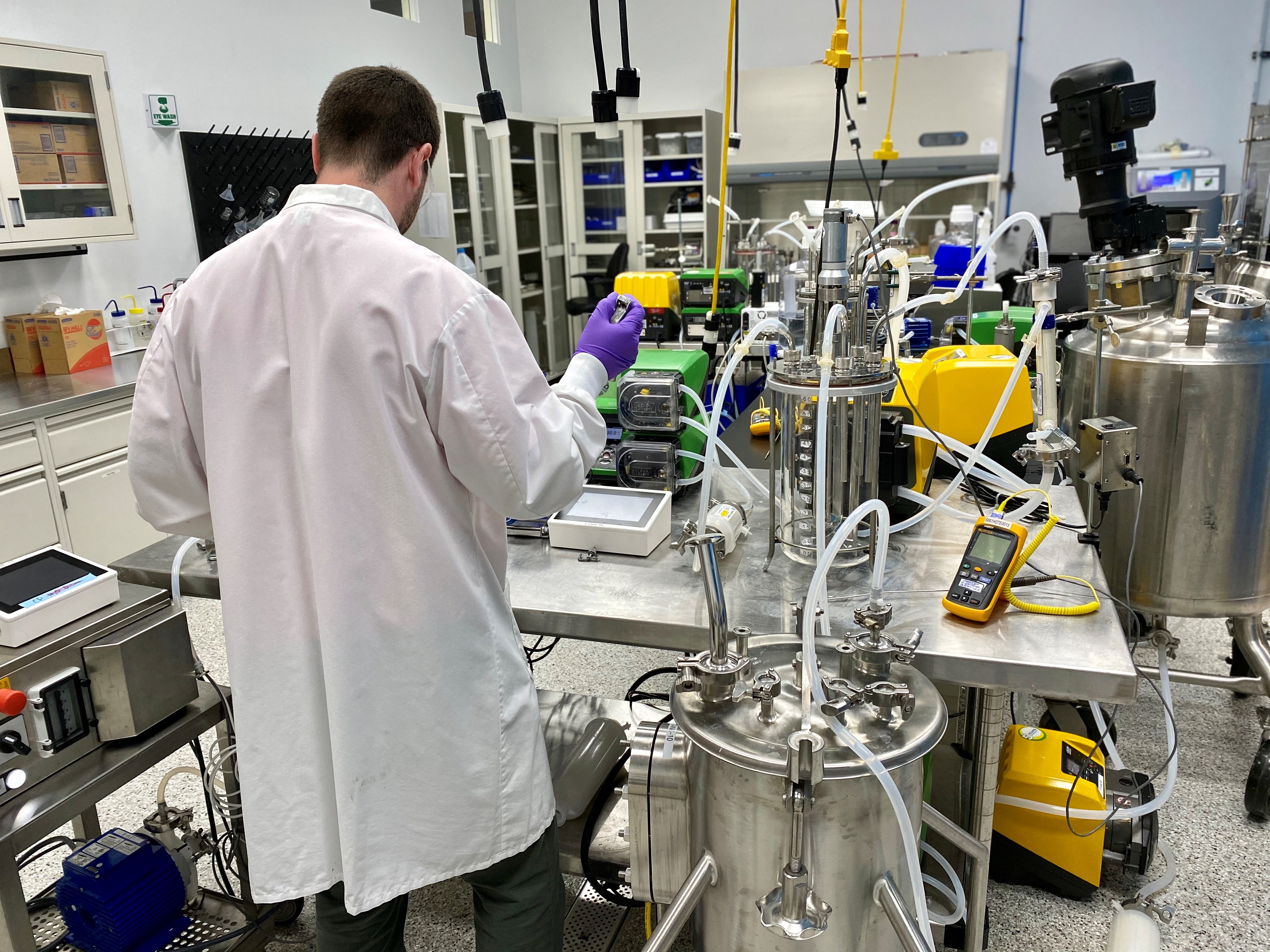Archives by Month: September 2024

Joint pain affects many people around the world, creating problems with everyday tasks, causing discomfort, and lessening their quality of life. Fortunately, advances in medicine have led to relief for those who suffer from a variety of conditions that result in joint pain, with long-acting injectables being an efficient method of delivery.
At Oakwood Labs, we’re a leader long-acting injectable development, putting our proven methodologies to work in drugs to treat joint pain. Read on to learn more about joint pain drug development and how the Oakwood Labs team can supply exactly what your operations need.
The History and Use of Long-Acting Injectables for Joint Pain Pharmaceuticals
Long-acting injectables were created in the 1950s to aid patients suffering from mental health conditions such as schizophrenia. As procedures evolved and new developments arose in the ensuing decades, the treatment of other conditions, including those centered more on the total body rather than just the mind, began to emerge. This includes using long-acting injectables to administer drugs for treating joint pain in knees, elbows, shoulders, and other problem areas.
Some of the common conditions that are suited for long-acting injectable medication distribution include:
- Osteoarthritis
- Rheumatoid arthritis
- Bursitis
- Tendonitis
- Psoriatic arthritis
Meanwhile, there are a range of medication types that may be distributed. These can include osteoarthritis pharmaceuticals, rheumatoid arthritis pharmaceuticals, and other forms, with specific injections containing:
- Corticosteroids
- Hyaluronic acid
- Platelet-rich plasma
- Additional formulations
Key Benefits of Long-Acting Pharmaceutical Drugs to Treat Joint Pain
Long-acting injectables, sometimes referred to as extended-release drugs or “ER drugs,” help to provide ongoing pain relief to patients who are suffering from an array of conditions. The result is a better quality of life, better pain management, increased mobility, and fewer dosages. Other benefits of these pharmaceuticals for treating joint pain include:
- Fewer side effects – Using long-acting injectable pharmaceuticals to treat joint pain can result in fewer side effects for patients because they will receive less frequent dosages than with immediate-release approaches. The reduced side effects are also facilitated by patients receiving lower peak concentrations of the given drug.
- Improved patient compliance – Since long-acting joint pain pharmaceuticals necessitate fewer doses, patients who take them are more likely to follow the plan put in place by their healthcare professionals. This results in improved pain management and happier patients.
- Reduced pain level fluctuations – Patients who take immediate-release drugs may notice a fluctuation in pain levels for their joint issues, but long-acting injectables lessen this experience, offering a more stable and controlled release that manages pain.
Our Abilities in Joint Pain Drug Development
The Oakwood Labs team has been proud to tackle projects for osteoarthritis drug development and rheumatoid arthritis drug development, providing long-acting injectables with a release duration of three months.
Our team specializes in developing pharmaceuticals that treat joint pain and can assist with developing formulations, scaling up the manufacturing process, and manufacturing clinical and commercial quantities under GMPs.
We find that long-acting injectables are ideal for use with pharmaceuticals for treating joint pain because joint pain often emanates from a specific bodily area and high concentrations of a drug can be administered without resulting in systemic exposure. This, and the potential for disease-modifying results, are yet more benefits to the LAI approach.
Our Work with LAI Formulations
In terms of our work, Oakwood has developed a 3-month LAI formulation of meloxicam. Meloxicam is one of the more potent NSAIDs, which enables targeted release in the intra-articular space, and thus avoids the systemic side effects of NSAIDs. Due to the high potency of meloxicam, a smaller injection volume is possible.
Challenges We Have Faced
One of the current barriers to entering this particular space is the difficulty of developing the proper formulation. Microspheres are preferable to gels that solidify after injection due to the mechanics of the joint and intra-articular space. Microspheres should be greater than 20 microns to avoid macrophages attacking them. Work with our team of LAI experts to develop the right formulation.
Partner with Us on Drugs to Treat Joint Pain
Oakwood Labs is actively looking to partner with interested organizations for co-development of programs such as those focused on treating joint pain. Be sure to visit our partnership page for more information on our approach and all areas we focus on. We would love to work with you to bring new drugs to market.
Have Questions About Pharmaceuticals to Treat Joint Pain? Contact Us
Reach out to the team at Oakwood Labs today and we can discuss our methodologies, facilities, previous projects, and more. We look forward to hearing from you.
At Oakwood Labs, we’re proud to contribute to the development of cancer pharmaceuticals through our continuous work manufacturing long-acting injectables (LAIs). That’s why we’ve compiled an informational guide showcasing our ongoing work in the healthcare field, as well as the numerous benefits of LAIs for oncology treatment.
Advantages of Long-Acting Injectables to Treat Cancer
There are numerous advantages to the use of LAIs as pharmaceuticals to treat cancer. To start, Bruton tyrosine kinase (BTK) inhibitors are established standards of care in multiple B-cell malignancies including chronic lymphocytic leukemia, mantle cell lymphoma, and Waldenstrom macroglobulinemia. LAI formulations of BTK inhibitors offer certain advantages in terms of pharmacokinetics (PK) and patient adherence. For example, ibrutinib (Imbruvica) has a very short half-life of 4-6 hours. Hence, relatively large doses of the oral form are required to target plasma levels within the therapeutic range.
The PK profile is marked by large peaks and valleys, sometimes exceeding the therapeutic level, and sometimes falling below. The PK profile of the LAI formulation is much “smoother,” having no significant peaks and valleys. Also, the oral bioavailability of ibrutinib is only 3% and varies among patients. The LAI formulation, meanwhile, is 100% bioavailable and therefore can be administered at much lower per-day doses.
These factors above could reduce side effects caused by off-target receptor interactions, while maintaining efficacy, and result in fewer cases in which the medication needs to be discontinued. The LAI formulations of two weeks and one month ensure patient adherence for these periods, possibly enhancing efficacy in clinical practice.
Similar benefits may be possible with other immunomodulatory cancer pharmaceuticals, such as the thalidomide analog pomalidomide (Pomalyst), indicated for multiple myeloma. The recommended dose for multiple myeloma is 4 mg per day taken orally on days 1 through 21 of repeated 28-day cycles. The half-life is approximately 7.5 hours and oral bioavailability is estimated to be approximately 75%. The LAI formulation reduces the peaks and valleys of drug exposure, enables a reduction in the total amount of drug administered, reduces the frequency of doses, possibly reduces side effects, and ensures patient adherence.
Additional Benefits to Highlight
Along with administration approaches and the long-term effects on the body, LAIs as oncology pharmaceuticals possess several key advantages for the patient, including:
- Reduced treatment burden
- Increased patient compliance
- Sustained stable hormone suppression
How Oakwood Labs Is Contributing to Cancer Drug Development
Alongside working with external partners who have been seeking out LAIs for their own initiatives, our team is also currently in the process of creating internal programs that utilize our very own microparticle technology. The goal of these internal initiatives is to convert an existing product into an LAI formulation to extend the duration of drug release to what is currently on the market, achieving patient compliance and ease of use.
More specifically, Oakwood Labs has used its internal technology to progress its formulations that are focused on treating mantle cell lymphoma, small lymphocytic lymphoma, chronic lymphocytic leukemia, and multiple myeloma with release durations ranging anywhere between two and four weeks. Our LAI oncology drug development has led to significant benefits for patients, such as:
- Reducing the amount of drug administered to the patient
- Decreasing the number of doses needing to be injected
- Diminishing more adverse reactions and side effects from dosages
Partnership Opportunities
At this point in the cancer drug development process, our team is actively seeking an external partner to help further develop our internal program. Key responsibilities in this area include funding ongoing development activities as well as phases one through three of clinical trials and registration/commercialization efforts.
If you’re interested in learning more about this opportunity, please contact our team directly, as we would be happy to provide additional details or answer any questions you may have.
FAQs About Oncology Pharmaceuticals, Development, and More
Can you provide me a brief history of oncology pharmaceutical development and its breakthroughs?
Though it is estimated that the preliminary study and treatment of cancer was initially recorded as early as 520 BCE when Persian queen Atossa was treated for a breast tumor, modern-day pharmaceuticals for treating cancer did not surface until relatively recently. Just some of the pivotal findings in this scientific journey include:
- The 1840s – Physician Rudolf Virchow is well-known for his observation of cancer cells during this time, in which he defined their key characteristics. This led to the future of cancer treatment protocols by the start of the 20th
- 1895 – Once German physicist Wilhelm Conrad Röntgen first correctly identified the waves of radiation that we all now know as X-rays, this equipment was then used in radiotherapy cancer treatment shortly thereafter.
- The 1940s – Based on the discovery that nitrogen mustard contains anticancer properties during World War II, researchers were able to develop various cytotoxic drugs to directly target dividing cancer cells, which later led to today’s chemotherapy practices.
Can you tell me more about the work Oakwood Labs does to develop LAIs?
Oakwood Labs performs LAI development through our technology platform Chroniject™, and some characteristics of products we have made with this system including the following:
- The duration of release is one week to one year
- LAIs are easily syringable with 18- to 23-gauge needles
- Products are reconstituted immediately with sterile water
- LAIs are filled aseptically and terminally sterilized if feasible
- Products have proven content uniformity and good stability characteristics
- LAIs are free of foreign particulate matter
Additionally, Chroniject™ is microsphere-based and has biodegradable polymers such as PLA, PLGA, and other polymers with demonstrated low toxicity and sourced from multiple suppliers. Plus, the finished dosage form typically consists of a lyophilized vial containing microspheres, a suspending agent, and other excipients.
What are the current barriers to an LAI entering this particular space?
The barrier to entry is that LAI formulations are extremely difficult to develop and require a high degree of technical expertise. Once developed, you then need to scale up the process to be able to manufacture in an aseptic GMP facility. The Oakwood Labs team can work with you to overcome key challenges.
What are some common trends in the development of drugs to treat cancer?
As healthcare professionals and pharmaceutical developers continue to produce different types of drugs for treating cancer, numerous trends have emerged from their discoveries, such as:
- Targeted drugs for treatment
- Immunotherapy
- Monoclonal antibodies
- Small molecule-targeted agents
- CRISPR
- Biomaterials, such as chitosan oligosaccharide (COS)
These recent practices have significantly advanced the oncology field, leading to longer, happier, and healthier lives for patients undergoing treatment.
Contact Oakwood Labs for More Information
If you have any additional questions about the oncology drug development process, or if you’re looking to get in touch with us regarding a potential partnership opportunity, please contact our team today. We look forward to assisting you.
Oakwood Labs is happy to announce that we will be at the 2024 Drug Delivery and Formulation Summit on September 17-18 in San Diego. If you would like to learn more about the event and register to attend, please visit the following link: https://ddfsummit.com/DDF2024/en/page/home
Company Overview
Oakwood Labs is a global leader in sustained release drug delivery. We support all phases of long acting injectable development from initial feasibility studies through FDA-approved clinical and commercial supply. Oakwood has 25 years of drug encapsulation experience using Chroniject™, our patented microsphere-based technology. Chroniject™ provides the ability to control particle size, customize release durations from weeks to years, and minimize residual solvents to achieve critical quality attributes.
Stop by Oakwood Lab’s Booth #20 to meet our team and learn more about how we can assist in the following areas:
- Long Acting Injectable Technology
- Feasibility studies
- Scale-up of formulation
- Manufacturing toxicology batches
- Clinical trial manufacturing (Phase I, II, III)
- Contract Manufacturing
- Technology Transfer
- GMP Registration and Validation batches
- Aseptic GMP commercial batch manufacturing
- ICH compliant stability testing
Contact Us for More Information
The DDF 2024 conference covers a wide range of topics, and we are happy to contribute to the event! If you aren’t able to attend, but still want to learn more about Oakwood Labs or what you missed at the conference, contact us today!
We look forward to discussing our technology and more.




